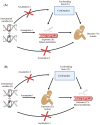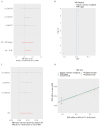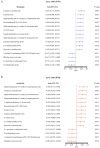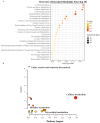Causal Metabolomic and Lipidomic Analysis of Circulating Plasma Metabolites in Autism: A Comprehensive Mendelian Randomization Study with Independent Cohort Validation
- PMID: 39452938
- PMCID: PMC11509474
- DOI: 10.3390/metabo14100557
Causal Metabolomic and Lipidomic Analysis of Circulating Plasma Metabolites in Autism: A Comprehensive Mendelian Randomization Study with Independent Cohort Validation
Abstract
Background: The increasing prevalence of autism spectrum disorder (ASD) highlights the need for objective diagnostic markers and a better understanding of its pathogenesis. Metabolic differences have been observed between individuals with and without ASD, but their causal relevance remains unclear.
Methods: Bidirectional two-sample Mendelian randomization (MR) was used to assess causal associations between circulating plasma metabolites and ASD using large-scale genome-wide association study (GWAS) datasets-comprising 1091 metabolites, 309 ratios, and 179 lipids-and three European autism datasets (PGC 2015: n = 10,610 and 10,263; 2017: n = 46,351). Inverse-variance weighted (IVW) and weighted median methods were employed, along with robust sensitivity and power analyses followed by independent cohort validation.
Results: Higher genetically predicted levels of sphingomyelin (SM) (d17:1/16:0) (OR, 1.129; 95% CI, 1.024-1.245; p = 0.015) were causally linked to increased ASD risk. Additionally, ASD children had higher plasma creatine/carnitine ratios. These MR findings were validated in an independent US autism cohort using machine learning analysis.
Conclusion: Utilizing large datasets, two MR approaches, robust sensitivity analyses, and independent validation, our novel findings provide evidence for the potential roles of metabolomics and circulating metabolites in ASD diagnosis and etiology.
Keywords: Mendelian randomization; autism spectrum disorder; causal inference; cohort validation; machine learning; metabolites.
Conflict of interest statement
The authors declare no conflicts of interest.
Figures








Similar articles
-
Inferring the genetic effects of serum homocysteine and vitamin B levels on autism spectral disorder through Mendelian randomization.Eur J Nutr. 2024 Apr;63(3):977-986. doi: 10.1007/s00394-024-03329-7. Epub 2024 Jan 24. Eur J Nutr. 2024. PMID: 38265752
-
Gut microbiota and autism spectrum disorders: a bidirectional Mendelian randomization study.Front Cell Infect Microbiol. 2023 Dec 14;13:1267721. doi: 10.3389/fcimb.2023.1267721. eCollection 2023. Front Cell Infect Microbiol. 2023. PMID: 38156319 Free PMC article.
-
Genetically predicted 1091 blood metabolites and 309 metabolite ratios in relation to risk of type 2 diabetes: a Mendelian randomization study.Front Genet. 2024 Jul 10;15:1356696. doi: 10.3389/fgene.2024.1356696. eCollection 2024. Front Genet. 2024. PMID: 39050247 Free PMC article.
-
Exploring the Association Between Human Blood Metabolites and Autism Spectrum Disorder Risk: A Bidirectional Mendelian Randomization Study.Health Sci Rep. 2025 Mar 3;8(3):e70528. doi: 10.1002/hsr2.70528. eCollection 2025 Mar. Health Sci Rep. 2025. PMID: 40041792 Free PMC article.
-
Causal effects of genetically determined metabolites and metabolite ratios on esophageal diseases: a two-sample Mendelian randomization study.BMC Gastroenterol. 2024 Sep 14;24(1):310. doi: 10.1186/s12876-024-03411-8. BMC Gastroenterol. 2024. PMID: 39271994 Free PMC article.
References
-
- Myers S.M., Voigt R.G., Colligan R.C., Weaver A.L., Storlie C.B., Stoeckel R.E., Port J.D., Katusic S.K. Autism Spectrum Disorder: Incidence and Time Trends Over Two Decades in a Population-Based Birth Cohort. J. Autism Dev. Disord. 2019;49:1455–1474. doi: 10.1007/s10803-018-3834-0. - DOI - PMC - PubMed
-
- Hyman S.L., Levy S.E., Myers S.M., Council on Children with Disabilities, Section on Developmental and Behavioral Pediatrics. Kuo D.Z., Apkon S., Davidson L.F., Ellerbeck K.A., Foster J.E., Noritz G.H., et al. Identification, Evaluation, and Management of Children with Autism Spectrum Disorder. Pediatrics. 2020;145:e20193447. doi: 10.1542/peds.2019-3447. - DOI - PubMed
Grants and funding
LinkOut - more resources
Full Text Sources

